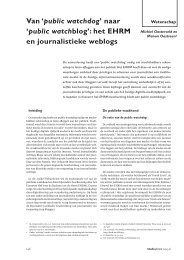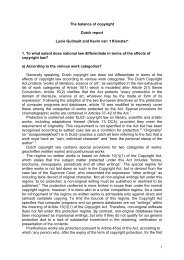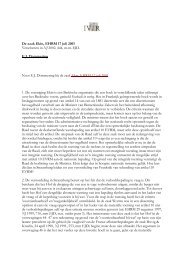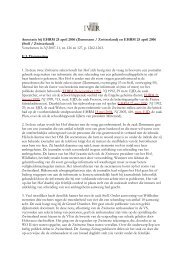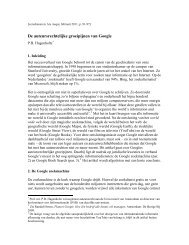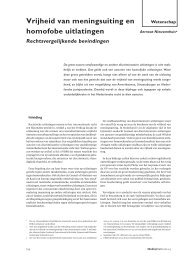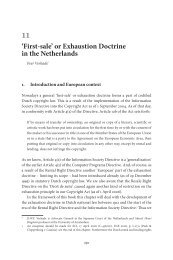ADAPTING COPYRIGHT TO THE INFORMATION ... - IViR
ADAPTING COPYRIGHT TO THE INFORMATION ... - IViR
ADAPTING COPYRIGHT TO THE INFORMATION ... - IViR
You also want an ePaper? Increase the reach of your titles
YUMPU automatically turns print PDFs into web optimized ePapers that Google loves.
Ironically, the implementation of encryption technology is being hampered, in many<br />
countries, by existing or proposed restrictions under public telecommunications law, for<br />
reasons of public security, to use encryption hardware devices or encoding software.<br />
2. Exploitation Rights on the Superhighway<br />
Copyright owners are protected by a bundle of exclusive exploitation rights. National<br />
legislators have applied different methods in defining the catalogue of exclusive rights,<br />
enumerating the various `restricted acts'. In some countries, copyright laws provide for<br />
rather detailed, media-specific definitions of the restricted acts. In others broader, and<br />
more abstract, notions of `reproduction', `distribution' and `communication to the public'<br />
are applied.<br />
Either way, the exploitation rights serve as abstractions of the various acts that constitute<br />
exploitation from an economic point of view. Many restricted acts are patterned after<br />
existing modes of exploitation: publication in book form, public performance,<br />
broadcasting, etc. However, the digital networked environment of the superhighway<br />
represents a radical change in the way copyrighted works are exploited. Mass<br />
distribution of copies or signals carrying identical information is replaced by<br />
transmission on individual demand of customized information.<br />
Thus, the existing set of exploitation rights, as defined in national or international legal<br />
instruments, does not necessarily reflect the manner in which protected works are<br />
communicated in the digital networked environment. The advent of the superhighway,<br />
therefore, presents legislators with a choice: either expand or modify existing `old media<br />
notions' 10 or redefine the catalogue of restricted acts, taking into account the peculiarities<br />
of the new environment.<br />
In examining these rights legislators (and courts) should not, in my opinion, focus on<br />
technological detail, but follow the normative approach inherent in the law of copyright.<br />
Existing rights and limitations are not merely technical, descriptive notions, but<br />
purpose-oriented; they must be applied and interpreted accordingly.<br />
Communicating copyrighted works on the superhighway may involve one or more of the<br />
following acts:<br />
* digital reproduction, adaptation<br />
* temporary storage<br />
* providing on-line access<br />
* point-to-point transmission<br />
* broadcasting<br />
* dissemination in closed user groups<br />
* decoding<br />
* screen display or use<br />
2.1 Digital reproduction and adaptation<br />
10 P. Geller, `The Universal Electronic Archive', IIC, Vol. 25 (1994), 54.



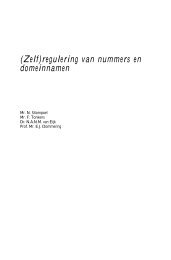
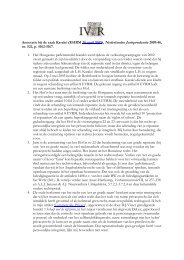

![Legal Opinion of Professor Egbert Dommering [1] concerning ... - IViR](https://img.yumpu.com/23603085/1/184x260/legal-opinion-of-professor-egbert-dommering-1-concerning-ivir.jpg?quality=85)
